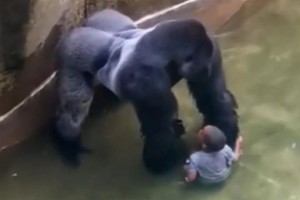What would you do if your child wandered away from you in public and you found yourself facing national scrutiny as well as possible criminal liability? That’s just what happened to Michelle Gregg and Deonne Dickerson after an incident with their three-year-old son at the Cincinnati Zoo over Memorial Day weekend.
On May 28th, the three-year-old boy climbed over a 3-foot barrier before falling 15 feet into a moat inside a gorilla enclosure. The boy was then confronted by Harambe, a 450- pound silverback gorilla. Harambe violently dragged and tossed the child around the enclosure before he was fatally shot by zookeepers.
Harambe’s death sparked international outrage. Critics lambasted the zookeepers for resorting to killing a member of an endangered species, as well as the boy’s parents for what they saw as their negligent behavior. In fact, a petition posted on change.org calling for Michelle Gregg to be investigated by Child Protective Services has over 60,000 signatures.
The Cincinnati police announced that they would look into filing criminal charges against the boy’s parents. However, on June 6th Ohio prosecutors announced that they would not be pressing charges.
But exactly what sort of legal liability could the boy’s family have faced? And could a case against the parents be seen as anything but frivolous?
Could the Boy’s Parents Have Been Charged For Harambe’s Death?
The outrage directed at Michelle Gregg and Deonne Dickerson after Harambe’s death is reminiscent of the backlash against Minnesotan Walter James Palmer. In 2015, Palmer shot and killed Cecil the lion while on a hunting expedition in Zimbabwe.
Like Harambe, Cecil was a member of an endangered species. Also like Harambe, Cecil lived under human observation–he resided in a national park where he was popular with tourists. While zookeepers shot Harambe in order to protect a child, Palmer hired two guides to assist him in killing the lion. Once in Africa, Palmer allegedly assisted in tying an animal carcass to the back of a vehicle to lure Cecil out of the park. Palmer later shot and killed Cecil after 40 hours of stalking him through the wilderness. 
However, the most important difference is that Palmer potentially faced charges under the Lacey Act, which makes it a federal crime to trade in wildlife killed in violation of foreign law. Palmer’s accomplices faced $20,000 in fines and up to 10 years in jail on poaching charges. There isn’t a comparable statute in the Harambe case. Ultimately, however, Palmer was not charged with a crime in Cecil’s death.
In lieu of a law that could directly charge anyone with Harambe’s death, outraged animal lovers urged supporters to sign a petition to instate “Harambe’s Law.” The petition, which will be delivered to an Ohio representative and a senator, asks that in the event of an incident similar to Harambe’s death “…the negligent party and or party’s [sic] be held financially and criminally responsible for any harm and or loss to an animal, specifically when said animal is Critically Endangered.”
Could the Parent’s Actions be Considered Child Endangerment?
If the boy’s parents had been found criminally liable, they might have been charged with child endangerment. According to Ohio Revised Code (ORC 2919.22), a caregiver commits child endangerment when he or she creates a “substantial risk to the health or safety of the child, by violating a duty of care, protection or support.” In other words, a parent or guardian who puts the child under their care in a situation where it is likely that the child will be exposed to harm could be found guilty of child endangerment.
While it might seem that a prohibition against exposing a child to harmful situations could make allegations of child endangerment a slam dunk to prosecute, this is not always the case. For example, while leaving a toddler unattended in a bathtub for up to four minutes could possibly be a situation that poses a “substantial risk to the health or safety” of a child, an Ohio court ruled that the mother in the case was not guilty. Similarly, another Ohio mother was not charged after she left her child unsupervised in a car in a mall parking lot.
However, there is an example of a parent who was held legally liable for an incident at a zoo. In 2015, a woman was sentenced to probation and parenting classes after she dropped her young child into a Cleveland zoo’s cheetah pit. The two-year-old child lunged out of his mother’s arms after she dangled him over a railing. The woman was charged with child endangerment, but eventually pleaded no contest to aggravated trespassing.
Although some animal lovers have been critical of what they see as Michelle Gregg’s parenting failure that day at the zoo, the charge of child endangerment does not hold up so easily in her case. According to witnesses, Gregg lost track of her child for perhaps two minutes. Unlike the Cleveland Cheetah case, Hamilton County prosecutor Joe Deters stated that he did not believe she acted in a way that put her son in danger.
So Would Charging the Boy’s Parents Have Made Any Sense?
While the death of Harambe was a loss to the Cincinnati Zoo and animal lovers everywhere, the prosecution’s decision not to press charges against Michelle Gregg is correct. After all, Michelle Gregg did not poach Harambe, as was alleged in the case of Walter Palmer. Additionally, the couple of minutes Gregg lost of her son does not rise to the standard of child endangerment.